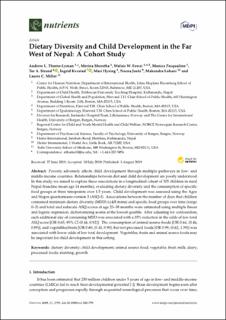| dc.contributor.author | Thorne-Lyman, Andrew L. | |
| dc.contributor.author | Shrestha, Merina | |
| dc.contributor.author | Fawzi, Wafaie W. | |
| dc.contributor.author | Pasqualino, Monica | |
| dc.contributor.author | Strand, Tor A | |
| dc.contributor.author | Kvestad, Ingrid | |
| dc.contributor.author | Hysing, Mari | |
| dc.contributor.author | Joshi, Neena | |
| dc.contributor.author | Lohani, Mahendra | |
| dc.contributor.author | Miller, Laurie C | |
| dc.date.accessioned | 2020-05-12T12:06:56Z | |
| dc.date.available | 2020-05-12T12:06:56Z | |
| dc.date.created | 2019-11-02T07:43:04Z | |
| dc.date.issued | 2019 | |
| dc.identifier.citation | Nutrients. 2019, 11:1799 (8), 1-14. | en_US |
| dc.identifier.issn | 2072-6643 | |
| dc.identifier.uri | https://hdl.handle.net/11250/2654085 | |
| dc.description.abstract | Poverty adversely affects child development through multiple pathways in low- and middle-income countries. Relationships between diet and child development are poorly understood. In this study, we aimed to explore these associations in a longitudinal cohort of 305 children in rural Nepal (baseline mean age 14 months), evaluating dietary diversity and the consumption of specific food groups at three timepoints over 1.5 years. Child development was assessed using the Ages and Stages questionnaire-version 3 (ASQ-3). Associations between the number of days that children consumed minimum dietary diversity (MDD) (≥4/8 items) and specific food groups over time (range 0-3) and total and subscale ASQ scores at age 23-38 months were estimated using multiple linear and logistic regression, dichotomizing scores at the lowest quartile. After adjusting for confounders, each additional day of consuming MDD was associated with a 35% reduction in the odds of low total ASQ score [OR 0.65, 95% CI (0.46, 0.92)]. The consumption of animal source foods [OR 0.64, (0.46, 0.89)], and vegetables/fruits [OR 0.60, (0.41, 0.90), but not processed foods [OR 0.99, (0.62, 1.59)] was associated with lower odds of low total development. Vegetables, fruits and animal source foods may be important for child development in this setting. | en_US |
| dc.description.sponsorship | This research was funded by United States Agency for International Development through the Feed the Future Innovation Lab for Nutrition [USAID grant number AID-OAA-L-1-00005], online at www. nutritioninnovationlab.org. | en_US |
| dc.language.iso | eng | en_US |
| dc.rights | Navngivelse 4.0 Internasjonal | * |
| dc.rights.uri | http://creativecommons.org/licenses/by/4.0/deed.no | * |
| dc.subject | animal source food; | en_US |
| dc.subject | child development; | en_US |
| dc.subject | dairy; | en_US |
| dc.subject | dietary diversity; | en_US |
| dc.subject | fruit; | en_US |
| dc.subject | growth; | en_US |
| dc.subject | milk; | en_US |
| dc.subject | processed foods; | en_US |
| dc.subject | stunting; | en_US |
| dc.subject | vegetable | en_US |
| dc.title | Dietary diversity and child development in the far west of Nepal: A cohort study | en_US |
| dc.type | Peer reviewed | en_US |
| dc.type | Journal article | en_US |
| dc.description.version | publishedVersion | en_US |
| dc.rights.holder | © 2019 by the authors. Licensee MDPI, Basel, Switzerland. This article is an open access article distributed under the terms and conditions of the Creative Commons Attribution (CC BY) license (http://creativecommons.org/licenses/by/4.0/). | en_US |
| dc.source.pagenumber | 1-14 | en_US |
| dc.source.volume | 11:1799 | en_US |
| dc.source.journal | Nutrients | en_US |
| dc.source.issue | 8 | en_US |
| dc.identifier.doi | 10.3390/nu11081799 | |
| dc.identifier.cristin | 1743417 | |
| cristin.unitcode | 1991,1,2,0 | |
| cristin.unitname | Avd Forskning | |
| cristin.ispublished | true | |
| cristin.fulltext | original | |
| cristin.qualitycode | 1 | |

